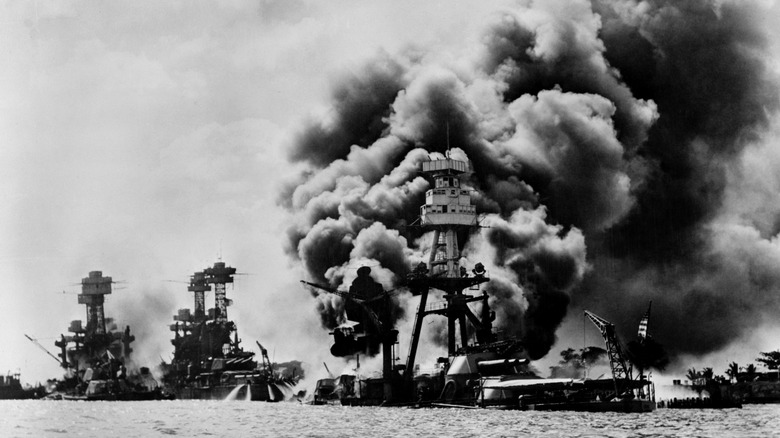The Macabre Reason Oil Continues To Leak Into Pearl Harbor
In most contexts, "My steel tomb leaks black tears in the depths of the sea" would be some decent black metal lyrics or goth musings from an admirer of Edgar Allen Poe. But when the "black tears" are oil, and the steel tomb a sunken battleship, and the sea the shallow waters of Pearl Harbor on the south side of Honolulu, Hawaii, that line takes on a whole new, literal layer.
Folks might remember that come 1941 Nazi Germany had invaded Belgium, the Netherlands, France, Northern Africa, and more, per a handy timeline on the World War II Foundation. The war's Axis powers — Germany, Japan, and Italy — eventually roped more than 30 countries into the bloodiest conflict in history. The United States was late to the party, and it took a direct attack on U.S. soil at Pearl Harbor, Hawaii, on December 7, 1941, to "awaken a sleeping giant," as Japanese Admiral Isoroku Yamamoto wrote in his diary, as VA News recounts.
Starting a little before 8 a.m. on the day in question, as NPR outlines, waves of Japanese fighters swept in and bombarded Pearl Harbor for almost two and a half hours. They killed over 2,400 people. Eighteen ships were also damaged or sunk, including the U.S.S. Arizona, which History says carried nearly 1.5 million gallons of fuel. That fuel continues to leak into the waters of Pearl Harbor to this day, and no one wants to clean it up because the ship is a "war grave."
A watery grave with a full fuel load
Eighteen ships might have been bombed by Japanese fighters on December 7, 1941, but as Pearl Harbor Tours describes, only seven of them sunk. Out of those seven, only two ships were beyond repair and left to the seas: the U.S.S. Utah and the U.S.S. Arizona. The U.S.S. Oklahoma was stripped for parts and sank after the war ended. The rest of the damaged ships were fixed and back in service by 1944 because the Japanese didn't attack any repair facilities or dry docks.
As a research paper from the University of Nebraska says, the carbon steel battleship U.S.S. Arizona was commissioned in 1916 and got some upgrades in 1930 in the form of new weaponry and armor. Nonetheless, the U.S.S. Arizona presented an easy, stationary target for Japanese fighter planes, whose bombs finally broke through the Arizona's armor when a 1760-pound bomb went straight through the front of the battleship and caused a cascade explosion within the battleship's armaments. It wasn't only the ship itself that suffered a mortal wound, though, but 1,177 men on board. The Arizona and its crew sunk into shallow water, and haven't moved since.
History reported that the battleship held 1.5 million gallons of fuel oil at the time it was attacked, as it had recently finished a complete refueling. In 2018, the University of Nebraska reported that more than 2,500 tons — around 79,000 gallons — remained. Bit by bit, it's still seeping into the ocean.
An unmovable memorial
As History says, the U.S.S. Arizona continues to seep 2.25 gallons of fuel oil into Pearl Harbor every single day. If the rate of oil loss remained constant since the University of Nebraska's 2018 estimate of 79,000 remaining gallons — and continues to remain constant — then the U.S.S. Arizona potentially has centuries of remaining oil leakage left. History mentions obvious environmental concerns about this issue, a study by the National Parks Service in the 1990s, and the potential for a "'catastrophic' eruption of oil" that would flood nearby waters with a deluge of remaining oil all at once.
And yet, the U.S.S. Arizona not only continues to stay put, but no one has touched it because it's technically a tomb. Not only did the ship itself sink, but it sank with people on board. In fact, per History, some surviving crew members of the U.S.S. Arizona elected to have their ashes scattered at the wreckage sight.
On top of this, the location of the sunken U.S.S. Arizona has itself become a tourist site, complete with its own observation facility stationed directly above the wreckage, as the National Parks Service shows. A little boat carries 3,000 to 5,000 visitors out to the observation facility every day, from which the Arizona and its rusted, decaying hull is fully visible in Pearl Harbor's clear, shallow water. For the foreseeable future, it certainly doesn't look like the Arizona and its remaining oil are going to be touched.


